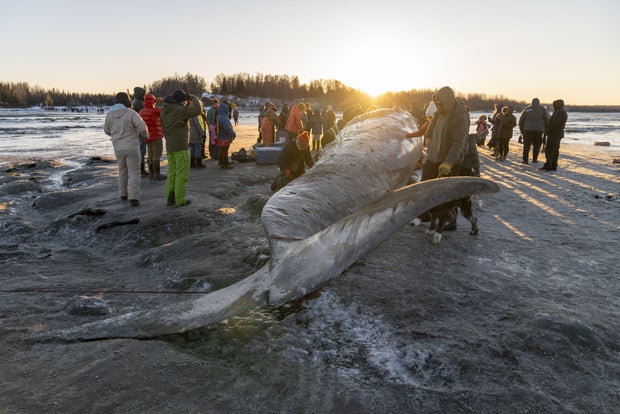An endangered fin whale that washed up near a coastal trail in Alaska’s largest city has attracted curious onlookers as biologists seek answers about what caused the animal’s death.
The carcass found near Anchorage this weekend was 45 feet (14.3 meters) long — comparable to the width of a college basketball court — and female, according to biologists with the National Oceanic and Atmospheric Administration.
Barbara Mahoney, a NOAA biologist studying the whale, told the Anchorage Daily News that the whale was probably 1 to 3 years old.
Fin whales are the second largest whale species, according to NOAA Fisheries. Fully grown whales can grow up to 25 meters in length and weigh between 40 and 80 tonnes. Attacks by shipscomplications fishing gearunderwater noise and its effects climate change are among the threats facing fin whales, according to the agency.
Hasan Akbas/Anadolu via Getty Images
Mandy Keogh, a NOAA marine mammal stranding coordinator, said fin whales are generally not seen this close to Anchorage and that recent high tides may have pushed the animal further into the Knik Arm.
People trekked across the mud flats to see the whale, which NOAA biologists and Alaska Veterinary Pathology Services staff anchored to the shore on Sunday so they could collect samples of the animal. But even after samples are analyzed, it can be difficult to determine the cause of death due to decomposition or a lack of obvious injuries, Keogh said.
Daisy Grandlinard was among the parents who accompanied a group of children to see the whale on Monday. As they got closer, they could smell it, she said.
“It was really interesting for the kids to be able to feel it, touch the bottom because there were kind of tracks on it, almost like a sled. And just to see the size of it, that was pretty cool,” she said . “We had already been studying whales a few weeks ago, so it was nice to see one in real life and say, ‘Oh, this is what the baleen looks like in real life’ and ‘Where’s the blowhole?’ “
Biologists hoped to complete their work Tuesday by loosening the carcass and “letting the tide push or move it,” Mahoney said. “Whatever it does or doesn’t do, we don’t know.”
According to NOAA, the whaling industry killed nearly 725,000 whales in the Southern Hemisphere alone in the mid-20th century. Today, the greatest threat to the species comes from ship strikes.
Other fin whales have washed ashore in the western U.S. this year. In August, a large fin whale washed up in Southern California and died before rescuers could arrive, CBS Los Angeles reported. Officials said the whale, which was not yet fully grown, was believed to be in poor health due to visible bumps on its skin and a thin build.
A 14 meter long whale was found in February washed up on the Oregon coast – emaciated, tangled and covered in what appear to be orca wounds.







